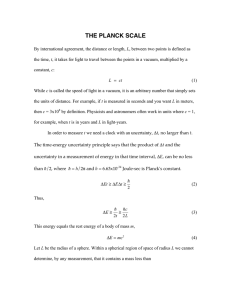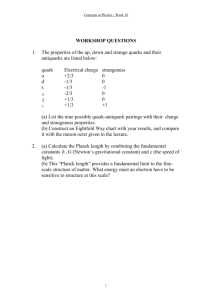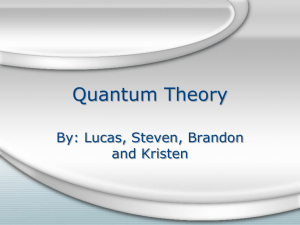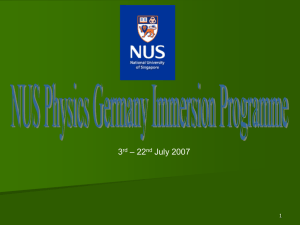THE PLANCK TIME
advertisement
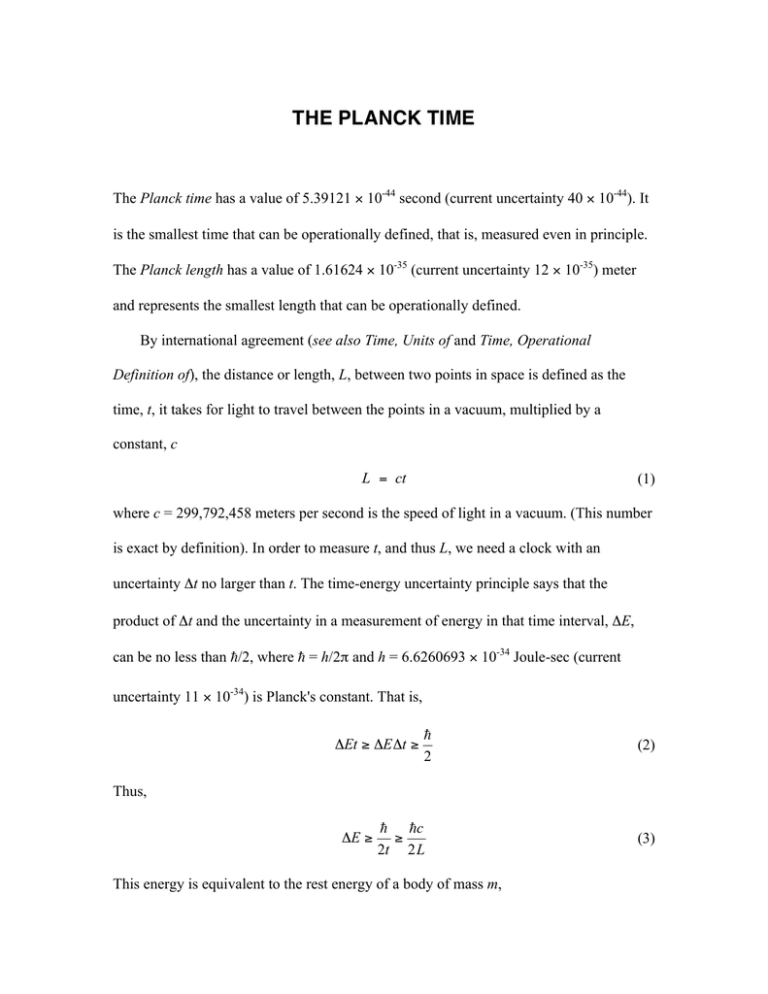
THE PLANCK TIME The Planck time has a value of 5.39121 × 10-44 second (current uncertainty 40 × 10-44). It is the smallest time that can be operationally defined, that is, measured even in principle. The Planck length has a value of 1.61624 × 10-35 (current uncertainty 12 × 10-35) meter and represents the smallest length that can be operationally defined. By international agreement (see also Time, Units of and Time, Operational Definition of), the distance or length, L, between two points in space is defined as the time, t, it takes for light to travel between the points in a vacuum, multiplied by a constant, c L = ct (1) where c = 299,792,458 meters per second is the speed of light in a vacuum. (This number is exact by definition). In order to measure t, and thus L, we need a clock with an uncertainty Δt no larger than t. The time-energy uncertainty principle says that the product of Δt and the uncertainty in a measurement of energy in that time interval, ΔE, can be no less than /2, where = h/2π and h = 6.6260693 × 10-34 Joule-sec (current uncertainty 11 × 10-34) is Planck's constant. That is, ΔEt ≥ ΔEΔt ≥ 2 (2) Thus, ΔE ≥ c ≥ 2t 2L This energy is equivalent to the rest energy of a body of mass m, (3) ΔE = mc 2 (4) Equation (3) implies that within a spherical region of space of radius L we cannot determine, by any measurement, that it contains a mass less than m= 2cL (5) Now, a spherical body of mass M will be a black hole if its radius R is less than or equal to R= 2GM c2 (6) where G = 6.6742 × 10-11 cubic meters per kilogram per square second (current uncertainty 10 × 10-11) is Newton's gravitational constant. This is called the Schwarzschild radius. Consider a body of mass m given in (5). Its Schwarzschild radius will be 1 ! G $ 2 LPL = # 3 & " c % (7) which is called the Planck length. Notice it is simply the length formed from the three basic constants in physics, , c, and G. It represents the smallest length that can be operationally defined, that is, defined in terms of measurements that can be made by any instrument. If we tried to measure a smaller distance, the time interval would be smaller, the uncertainty in rest energy larger, the uncertainty in mass larger, and the region of space would be experimentally indistinguishable from a black hole. Since nothing inside a black hole can climb outside its gravitational field, we cannot see inside and thus cannot make smaller measurement of distance. Similarly, we can make no smaller measurement of time than the Planck time, 1 t PL LPL ! G $ 2 = =# 5 & c " c % (8) The Planck time and Planck length are the most basic units of time and space. Although distance and time are assumed continuous variables, they are fundamentally discrete. However, since physics experiments have not yet even come close to probing space and time on the Planck scale, treating them as continuous remains a good approximation. General relativity, they theory of gravity introduced by Albert Einstein in 1915, has so far passed every empirical test to high precision. However, not being a quantum theory it can be expected to break down at the Planck scale, where it will have to be replaced by a quantum theory of gravity, still not developed. The Planck time represents the earliest time that can be operationally defined for our Universe on the positive side of the time axis. However, this does not mean that "time began" at that moment. Nothing forbids and time symmetry (see Time, symmetry of) implies another universe at earlier times, on the negative side of our time axis. FURTHER READING Stenger, Victor J. (2006). The Comprehensible Cosmos: Where Do the Laws of Physics Come from? Amherst, NY: Prometheus Books.
